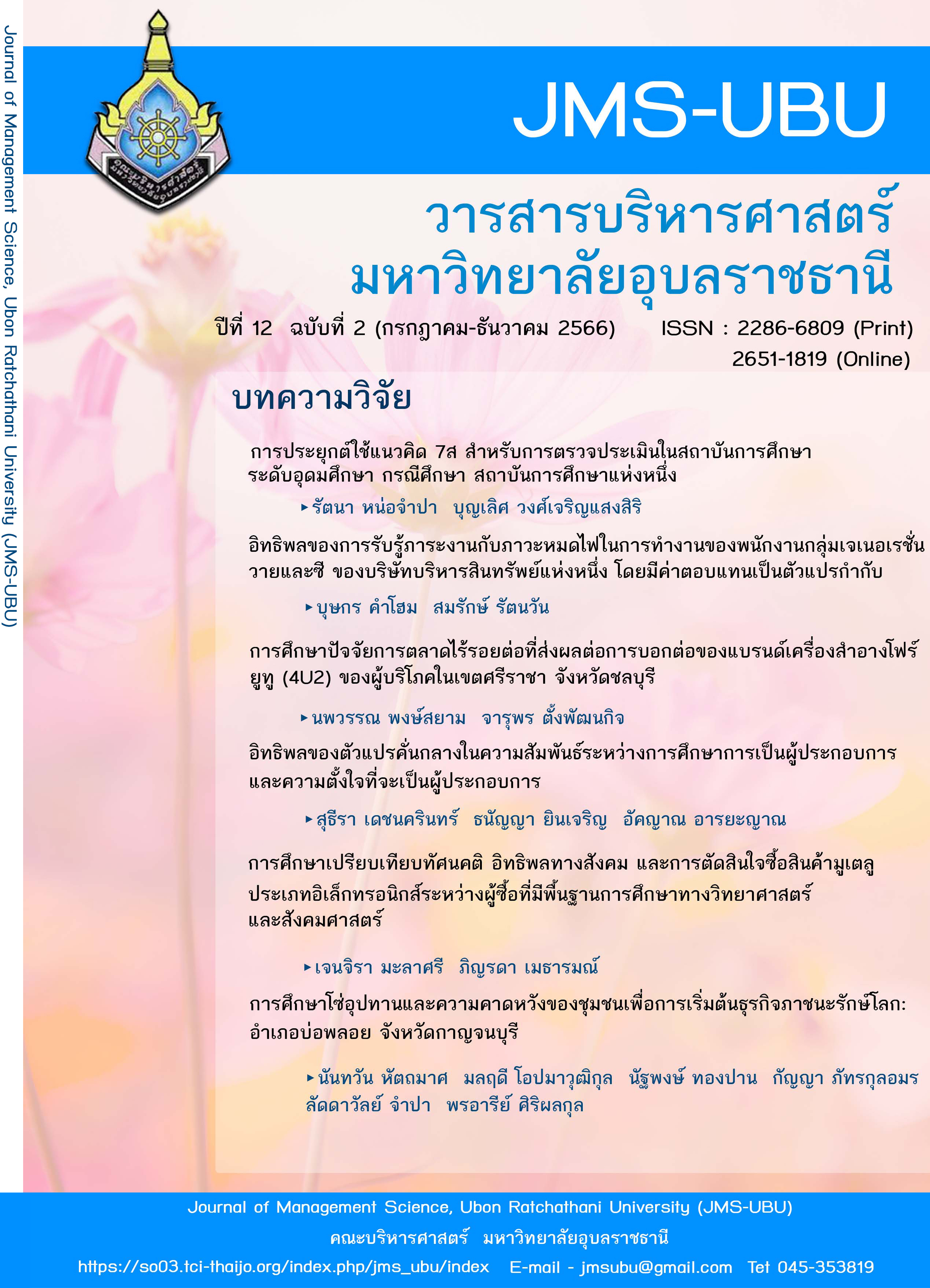การศึกษาปัจจัยการตลาดไร้รอยต่อที่ส่งผลต่อการบอกต่อของแบรนด์ เครื่องสำอางโฟร์ยูทู (4U2) ของผู้บริโภคในเขตศรีราชา จังหวัดชลบุรี
Main Article Content
บทคัดย่อ
งานวิจัยเชิงปริมาณนี้ มีวัตถุประสงค์เพื่อศึกษาปัจจัยการตลาดไร้รอยต่อที่ส่งผลต่อการบอกต่อของแบรนด์เครื่องสำอางโฟร์ยูทู (4U2) ของผู้บริโภคในเขตศรีราชา จังหวัดชลบุรี เก็บข้อมูลด้วยแบบสอบถามจากกลุ่มตัวอย่าง จำนวน 424 คน ที่เป็นลูกค้าหรือต้องรู้จักแบรนด์เครื่องสำอาง 4U2 และอาศัยในเขตศรีราชา จังหวัดชลบุรี โดยใช้แบบสอบถามที่ตรวจสอบความเที่ยงตรงจากผู้ทรงคุณวุฒิ 3 ท่าน นำไปวิเคราะห์ข้อมูลด้วยวิธีการประเมินค่าดัชนีความสอดคล้องของเครื่องมือวิจัย (IOC) ได้ค่า เท่ากับ 0.811 จากนั้นจึงนำแบบสอบถามไปเก็บข้อมูล และใช้โปรแกรมสำเร็จรูป ใช้วิเคราะห์สถิติ ได้แก่ ค่าเฉลี่ย ค่าความถี่ ค่าร้อยละ ส่วนเบี่ยงเบนมาตรฐาน ทดสอบสมมติฐานด้วยวิธีการถดถอยพหุคูณ ผลการวิจัยพบว่า ปัจจัยการตลาดไร้รอยต่อส่งผลต่อการบอกต่อของแบรนด์เครื่องสำอาง 4U2 โดยมีประสิทธิภาพในการพยากรณ์เท่ากับ 0.654 (R2= 65.4%) ปัจจัยการตลาดไร้รอยต่อส่งผลต่อการบอกต่อของแบรนด์เครื่องสำอาง 4U2 ต่อผู้บริโภค อย่างมีนัยสำคัญที่ระดับ 0.05 ประกอบด้วย ปัจจัยด้านการเชื่อมโยงช่องทางเข้าหาผู้บริโภค (β = 0.194; Sig. = 0.000) ปัจจัยด้านการเข้าใจพฤติกรรมและความคาดหวังของผู้บริโภค (β = 0.111; Sig. = 0.017) ปัจจัยด้านการมอบประสบการณ์ที่ตรงต่อความต้องการของผู้บริโภคอย่างต่อเนื่อง (β = 0.105; Sig. = 0.018) และปัจจัยด้านการสร้างความผูกพันกับผู้บริโภค (β = 0.508; Sig. = 0.000)
Downloads
Article Details

อนุญาตภายใต้เงื่อนไข Creative Commons Attribution-NonCommercial-NoDerivatives 4.0 International License.
เอกสารอ้างอิง
เกสรา กิจศุภสิน. (2564). ปัจจัยของการตลาดแบบไร้รอยต่อ (Omni Channel Marketing) ที่ส่งผลต่อการตัดสินใจซื้อสินค้าจากเซ็นทรัลดีพาร์ทเม้นต์สโตร์ของผู้บริโภคในเขตกรุงเทพมหานคร. (การค้นคว้าอิสระปริญญามหาบัณฑิต). มหาวิทยาลัยกรุงเทพ, คณะบริหารธุรกิจ.
คอสเมเน็ต. (ม.ป.ป.). ข้อมูลเครื่องสำอาง 4U2 (ออนไลน์). สืบค้นเมื่อ 21 มิถุนายน 2564, จาก https://www.cosmenet.in.th/brand/2778/4u2
ชัชฌาพร กลางโฉม. (2564). การตลาดไร้รอยต่อที่ส่งผลต่อการตัดสินใจซื้อผลิตภัณฑ์จากสวนดุสิตโฮมเบเกอรี่. (วิทยานิพนธ์ปริญญามหาบัณฑิต). มหาวิทยาลัยศิลปากร, คณะบริหารธุรกิจ.
บุริม โอทกานนท์. (2554). โอกาสของธนาคารธนชาต. จุฬาลงกรณ์วารสาร, (23), 91.
ปัทมวรรณ อินยิ้ม. (2562). กระบวนการตัดสินใจซื้อผลิตภัณฑ์บำรุงผิวหน้า (Facial Skincare) ของผู้บริโภคที่อาศัยในกรุงเทพมหานคร. (วิทยานิพนธ์ปริญญามหาบัณฑิต). มหาวิทยาลัยรามคำแหง, คณะบริหารธุรกิจ.
พชร อารยะการกุล. (2562). สร้างธุรกิจอย่างเหนือชั้นด้วยประสบการณ์แบบ Omni-channel. สืบค้นเมื่อ 21 มิถุนายน 2564, จาก https://forbesthailand.com/commentaries/insights/เพิ่มมูลค่าและสร้างฐาน.html
พัลลภา ปีติสันต์. (2563). รอดอย่างไรจากวิกฤต…จากธุรกิจติดหนี้ 40 ล้าน. สืบค้นเมื่อ 21 มิถุนายน 2564, จาก https://shorturl.asia/MEho7
พิษณุ ลาภชัยเจริญกิจ, ภาศิริ เขตปิยรัตน์, และกัลยรัตน์ คำพรม. (2565). การตลาดแบบผสานทุกช่องทางที่มีอิทธิพลต่อการตัดสินใจซื้อสินค้าไอที ของผู้บริโภคในประเทศไทย. วารสารวิชาการการจัดการภาครัฐและเอกชน, 4(3), 31-46.
มีเมทาปรียา. (2557). Omni Channel Marketing อนาคตของร้านค้าปลีก. สืบค้นเมื่อ 21 มิถุนายน 2564, จากhttps://blog.lnw.co.th/2014/05/20/omni-channel-marketing/
ศรัญญู ทิยะมุข. (2565). ปัจจัยการตลาดแบบไร้รอยต่อ (Omni Channel Marketing) ที่ส่งผลต่อการตัดสินใจซื้อสินค้าของผู้บริโภคร้าน Watsons ในประเทศไทย. (การค้นคว้าอิสระปริญญามหาบัณฑิต). มหาวิทยาลัยกรุงเทพ, คณะบริหารธุรกิจ.
ศิริวรรณ เสรีรัตน์ และ ศุภร เสรีรัตน์. (2560). การบริหารตลาดยุคใหม่. กรุงเทพฯ: พัฒนาศึกษา.
อรรัมภา หัวใจ, จิดาภา หิรัญวงศ์สว่าง, ศรุต ชินประพินพร, ธีราพร เมฆอาภรณ์, ธนวรรณ ธนพรวิริยะกุล, ตปนีย์ ทิพย์ผ่อง,… พิชญา รัศมีจันทร์. (2557). Omni-channel marketing (ตอนที่ 2). For Quality Management, 21(203), 65-67.
อสมาภรณ์ เขียวมีส่วน. (2561). การศึกษาถึงความมีอิทธิพลของการตลาดแบบไร้รอยต่อ (Omni Channel Marketing) ที่ส่งผลต่อความภักดีของลูกค้าอิเกียในประเทศไทย. (การค้นคว้าอิสระปริญญามหาบัณฑิต). มหาวิทยาลัยกรุงเทพ คณะบริหารธุรกิจ.
ไอแพลน ดิจิทัล. (2564). Unified Commerce คืออะไร? ซอฟต์แวร์ที่จำเป็นสำหรับอีคอมเมิร์ซ? สืบค้นเมื่อ 21 มิถุนายน 2564, จาก https://www.iplandigital.co.th/ecommerce/unified-commerce/
Assael, H. (2004). Consumer Behavior: A Strategic Approach. Boston: Houghton Mifflin.
Beck, N., & Rygl, D. (2015). Categorization of multiple channel retailing in multi-, cross-, and omni-channel retailing for retailers and retailing. Journal of Retailing and Consumer Services, 27, 170-178.
Bilro, R. G., Loureiro, S. M. C., & Guerreiro, J. (2019). Exploring online customer engagement with hospitality products and its relationship with involvement, emotional states, experience and brand advocacy. Journal of Hospitality Marketing & Management, 28(2), 147-171.
Cetin, G., & Dincer, F. I. (2014). Influence of customer experience on loyalty and word-of-mouth in hospitality operations. Anatolia, 25(2), 181-194.
Cochran, W. G. (1977). Sampling Techniques (3rd ed.). New York: John Wiley & Sons
Hennig-Thurau, T., Gwinner, K. P., Walsh, G., & Gremler, D. D. (2004). Electronic word-of- mouth via consumer-opinion platforms: What motivates consumers to articulate themselves on the internet? Journal of Interactive Marketing, 18(1), 38-52.
Hennig-Thurau, T., Henning, V., & Sattler, H. (2007). Consumer file sharing of motion pictures. Journal of Marketing, 71(4), 1-18.
Kim, J., Naylor, G., Sivadas, E., & Sugumaran, V. (2015). The unrealized value of incentivized eWOM recommendations. Marketing Letters, 27, 411-421.
Kotler, P. (2003). Marketing Insights from A to Z: 80 Concepts Every Manager Needs to Know. New York: John Wiley & Sons.
Kotler, P., & Keller, K. (2006). Marketing Management (12th ed.). Upper Saddle River, NJ: Prentice Hall.
Lee, J., & Lee, J. N. (2009). Understanding the product information inference process in electronic word-of-mouth: An objectivity-subjectivity dichotomy perspective. Information and Management, 46(5), 302-311.
Linden, D. J. (1994). Long-term synaptic depression in the mammalian brain. Neuron, 12(3), 457-472.
Litvin, S. W., Goldsmith, R. E., & Pan, B. (2008). Electronic word-of-mouth in hospitality and tourism management. Tourism Management, 29(3), 458-468.
Lusch, R. F., Vargo, S. L., & O’brien, M. (2007). Competing through service: Insights from service-dominant logic. Journal of Retailing, 83(1), 5-18.
Nyilasy, G. (2006). Practitioner theories at the advertising agency: Evidence on the academician-practitioner gap and the professional status of advertising. (Doctoral dissertation). The University of Georgia, Graduate School.
Richins, M. L., & Root-Shaffer, T. (1988). The role of evolvement and opinion leadership in consumer word-of-mouth: An implicit model made explicit. ACR North American Advances, 15(1), 32-36.
Rigby, D. (2011). The future of shopping. Harvard Business Review, 89(12), 65-76.
Rosen, E. (2000). The Anatomy of Buzz: How to Create Word of Mouth Marketing. New York: Doubleday.
Sallam, M. A. (2014). The effects of brand image and brand identification on brand love and purchase decision making: The role of WOM. International Business Research, 7(10), 187-193.
Silverman, G. (1997). How to harness the awesome power of word of mouth. Direct Marketing, 60(7), 32–37.
Verhoef, P. C., Kannan, P. K., & Inman, J. J. (2015). From multi-channel retailing to omni-channel retailing: Introduction to the special issue on multi-channel retailing. Journal of Retailing, 91(2), 174-181.

